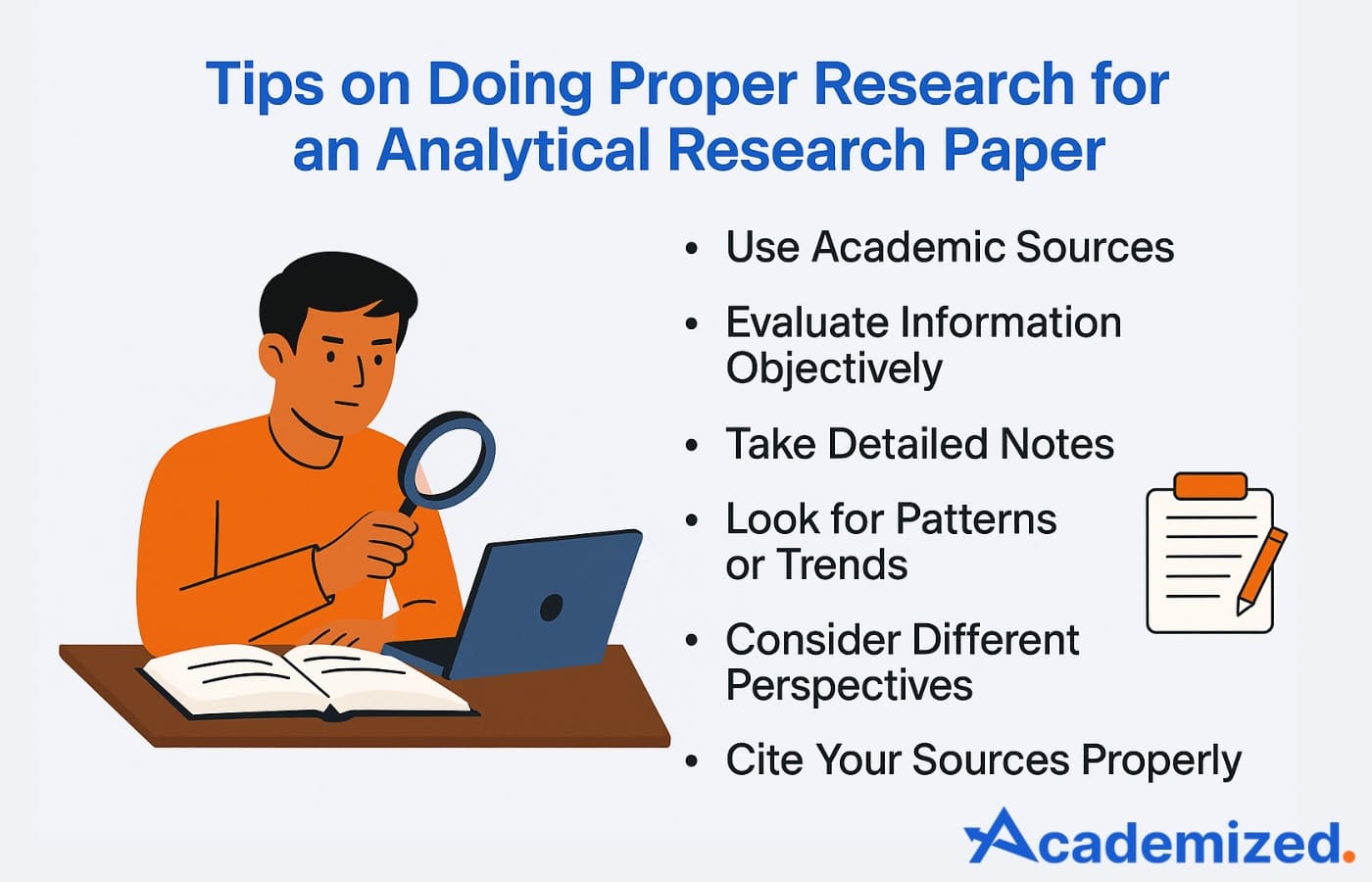- Blog
- How to Write an Analytical Research Paper: Full Guide
How to Write an Analytical Research Paper: Full Guide
 Mary Watson
Mary Watson

Do you want to know how to write an analytical research paper that goes beyond facts and quotes? Start by choosing a topic that invites critical thinking, not just description. Then, dig into the “why” and “how” behind your sources, not just the “what.” A strong analytical paper breaks down information, examines relationships, and draws logical conclusions based on evidence, not opinions.
At our writing service, we’ve helped thousands of students master this process, and in this article, we’re sharing the exact steps to help you do the same. Whether you’re just starting or stuck mid-draft, this guide will walk you through everything you need to write a focused, thoughtful, academically solid paper!
Getting to Know What an Analytical Research Paper Is
If you’ve ever been asked to do more than just explain a topic, you’ve likely been assigned an analytical research paper. This type of writing goes beyond reporting facts, requiring more profound thought and clear reasoning. Instead of gathering data, you're asked to break it down, explore relationships, and uncover meaning.
Let’s take a closer look at what this type of paper is, how it’s different from a regular analytical essay, and what makes it effective.
What is an Analytical Research Paper, and Why it Matters
An analytical research paper is a form of academic writing that investigates an issue, question, or idea by collecting evidence from multiple sources and examining it critically. The writer doesn’t just present facts – they analyze them to reveal patterns, contradictions, or new insights. This kind of paper aims to better understand a subject by breaking it apart and exploring how different pieces connect. It’s not about taking sides or persuading anyone. Instead, it’s about asking thoughtful questions, forming a central claim or hypothesis, and backing it up through objective, well-organized analysis.
Analytical Research Paper vs Analytical Essay
At first glance, an analytical essay and an analytical research paper might sound like the same thing, but they serve different purposes.
An analytical essay usually focuses on interpreting a single text, issue, or idea, often based on personal insights or classroom discussions. It’s shorter and relies heavily on your interpretation.
An analytical research paper, on the other hand, is much broader. It requires outside research, uses multiple sources, and builds its argument around evidence collected from those sources. While both involve analysis, the research paper is more in-depth, formal, and structured like a scholarly investigation.
Read more: Learn How to Write an Analytical Essay
Main Features of Analytical Research Papers
Every strong analytical research paper shares certain features that make it stand out. These elements help readers follow the writer’s thinking, evaluate the argument, and understand the conclusions. If you want to learn how to write a good analytical research paper, focus on the traits below:
- Clear research question or problem. Strong papers begin with a specific question that drives the analysis and sets the focus.
- Neutral, fact-based tone. The writing avoids bias or persuasion and stays rooted in evidence.
- Logical structure. The paper flows in a clear, step-by-step order, helping readers track the argument easily.
- Strong thesis supported by analysis. A central claim guides the paper, backed by an interpretation of data and source material.
- Use of multiple credible sources. A wide range of reliable information is used to strengthen the analysis and build credibility.
- Consistent citations and formatting. A proper citation style gives the work a professional look and avoids plagiarism.
- Balanced perspective. The paper may consider different views or outcomes, showing the writer has fully explored the topic.
Having trouble with a tricky research paper? Hire a cheap research paper writer from Academized and get stress-free academic support with any project.
How to Write an Analytical Research Paper: A Detailed Guide
Planning to write a research paper that’s more than just a collection of facts? You’ll need a straightforward process to break things down, ask the right questions, and support your ideas with solid evidence.
Looking for innovative ways to write an analytical research paper? Start by choosing a focused topic, gathering trustworthy sources, and building a strong foundation through planning and structure. Let’s walk through each key step in the writing process so you can approach your paper with clarity and confidence!
Step 1: Pick a Strong Topic
A strong analytical paper starts with an interesting and specific subject. It should allow room for critical thinking, not just surface-level description. Ideally, your topic should reflect current trends or debates in your field. The goal is to explore how or why something happens, not just what it is. Here are 10 trending topic ideas to consider:
- The Psychological Effects Of Social Media Algorithms
- Climate Migration And Its Impact On Global Economies
- Ethical Challenges In Artificial Intelligence Development
- How Fast Fashion Fuels Environmental Degradation
- The Role Of Misinformation In Political Polarization
- Mental Health Trends Among Remote Workers
- Privacy Concerns Linked To Wearable Health Tech
- Cultural Representation In Modern Video Games
- How E-Learning Is Changing Traditional Education Models
- Media Influence On Public Health Decisions
Step 2: Perform Deep Research
Before putting any ideas on the page, it’s essential to gather strong evidence from credible sources. Academic journals, books, government reports, and verified databases are all excellent places to start.
Research isn’t just about collecting quotes – it’s about understanding the context, spotting patterns, and identifying gaps or contradictions in what others have said.
As you read, take organized notes and group your findings by theme or viewpoint. Keep track of sources for proper citation later. Good research lays the groundwork for sharp analysis and gives your paper the depth it needs.

Step 3: Create a Clear Thesis Statement
Every excellent analytical paper has a central point that guides the entire discussion. A thesis in this context isn’t just a simple statement – it’s a specific claim based on your research that your paper will explore and support.
When writing a thesis for an analytical research paper, aim for clarity and direction. Don’t make a broad statement or a personal opinion. Instead, point to a connection, pattern, or cause-and-effect relationship your research uncovered. This single sentence will keep your analysis on track and help readers understand what you’re trying to prove.
Step 4: Write a Detailed Analytical Research Paper Outline
An outline is a planning tool used before you start writing. It acts like a roadmap, helping you organize your thoughts and decide where each idea fits best in your paper. A helpful outline should include:
- Thesis statement – the main idea your paper will explore
- Main points – each key argument or section of your analysis
- Supporting evidence – sources, data, or quotes for each main point
- Section headings – clear labels for the introduction, body, and conclusion
- Transitions – notes on how you’ll connect ideas between paragraphs
Step 5: Follow a Clear Analytical Research Paper Structure
A strong structure is the foundation of any analytical research paper and helps present your ideas clearly and logically. It guides readers through your argument and ensures each part of your analysis builds on the last. A typical structure includes three main parts:
- Introduction – introduces the topic, provides background, and ends with a focused thesis statement
- Body paragraphs – each begins with a topic sentence, followed by evidence, analysis, and a transition to the next idea
- Conclusion – restates the thesis in new words, summarizes key findings, and explains the broader importance of your analysis
Step 6: Write a Strong Analytical Research Paper Introduction
An introduction sets the stage for your analysis and helps the reader understand what to expect. This paragraph should grab attention, give context, and clearly state your thesis. Instead of rushing into facts, take a moment to guide the reader into the topic. Here’s what to include in your introduction:
- An engaging hook – Start with a question, a surprising fact, or a brief example related to your topic
- Relevant background – Provide just enough information to help readers follow your focus
- A clear thesis statement – Present your central argument or idea without making it too broad or vague
- Smooth transition – Lead naturally into the body of your paper
Step 7: Develop Concise Analytical Research Paper Body Paragraphs
In the body of your paper, each paragraph should tackle one idea or piece of analysis that supports your thesis. Begin with a topic sentence that connects to your main argument. Then, present the evidence you’ve found – this could be statistics, quotes, or data from your research. However, simply listing facts isn’t enough. You must explain how those facts connect, what they show, and why they matter. Analysis means breaking down the material, showing cause and effect, drawing comparisons, or pointing out contradictions. Paragraphs should build on one another, strengthening the case with each new point.
Step 8: Write an All-Encompassing Analytical Research Paper Conclusion
The conclusion is your chance to wrap things up and show the bigger picture. Rather than just repeating your thesis, restate it in a fresh way that reflects the insights you’ve developed. This section should remind readers why your analysis matters and what they should take away from it. You might briefly summarize your main points, but the focus should be on the overall impact. If it fits, suggest how your findings connect to a larger issue, trend, or future question worth exploring.
Step 9: Cite Sources Correctly
Giving credit to your sources shows academic honesty and builds trust in your work. Proper citations also help readers find the original material if they want to dig deeper. Here are a few quick tips:
- Use the correct style guide – Follow MLA, APA, or Chicago as assigned
- Cite both in-text and at the end – Include brief citations in the body and full entries in a bibliography or reference page
- Double-check every source – Make sure each citation matches a real source used in your paper
- Stay consistent – Don’t mix citation styles or formatting
- Use citation tools with caution – Automated generators can help, but always verify accuracy
Step 10: Make the Final Edits
After the first draft is complete, step away before reviewing it again. A fresh read can help spot weak transitions, off-topic sections, or unclear sentences. Revision is about structure and clarity, while proofreading focuses on grammar, spelling, and formatting.
Don’t rely only on spellcheck. Read your paper aloud to catch awkward phrasing and check for missing citations or formatting errors. Ask someone else to read your work and give honest feedback if possible.
That final round of polishing can make a big difference between a paper that’s just okay and one that feels complete and professional.
Read more: How to Write a Good Research Paper
Analytical Research Paper Format That Works
Formatting might not be the most exciting part of writing a paper, but it plays a big role in how your work is received. A clean, consistent format helps readers focus on your analysis without distraction and shows you’ve taken the assignment seriously. Follow these formatting tips to keep your paper organized and professional:
- Use a readable font like Times New Roman or Arial, size 12
- Keep margins set at 1 inch on all sides
- Double-space the entire document, including headings and references
- Align your text to the left (not justified)
- Include page numbers in the upper right corner if required
- Title your paper clearly and center it above the introduction
- Indent the first line of each paragraph
- Use headings to break up sections (if allowed by your instructor)
- Stick to the assigned citation style (APA, MLA, Chicago, etc.)
- Include a works cited or reference page with full source details
A Professionally Written Analytical Research Paper Example
Before diving into your draft, it helps to see how the pieces come together. Below is a short analytical research paper example that shows how to build a thesis, structure body paragraphs, and use evidence to support a central claim.
Title: The Impact of Social Media on Teen Sleep Patterns
Social media has become part of most teenagers' daily routines. While it allows for social connection, entertainment, and information sharing, it has also been linked to changes in sleep behavior. This paper explores how frequent nighttime use of social media disrupts teens’ sleep cycles, affects academic performance, and contributes to long-term health concerns.
Recent studies show that screen exposure before bedtime delays the body’s natural release of melatonin, which helps control sleep. According to the Sleep Foundation, blue light emitted from phones and tablets can suppress melatonin production, making it harder for teens to fall asleep. When social media apps are used right before bed, the brain stays active and alert, reducing sleep quality.
In addition to biological disruption, social pressure also plays a role. Many teens need to stay connected late at night so they don’t miss out on conversations or group messages. This behavior, often called “fear of missing out” or FOMO, leads to longer screen time and shorter sleep. Over time, this sleep loss can impact concentration in school, lower mood, and even raise stress levels.
Long-term effects of poor sleep in teens can be severe. Chronic sleep deprivation has been connected to anxiety, depression, and weakened immune response. This pattern becomes harder to break when combined with academic stress and physical changes during adolescence. Researchers suggest limiting device use before bedtime and promoting healthier habits to protect sleep and well-being.
In conclusion, social media has reshaped how teenagers interact and disrupts their sleep. Late-night screen exposure and social demands lead to reduced rest and greater health risks. Understanding this link can help schools, parents, and teens make better screen time decisions.
Analysis
This sample paper clearly defines a central question and builds an analysis around it. Each paragraph introduces a specific point, backs it up with evidence, and connects it to the main idea. The writer explains how facts support the thesis instead of simply listing information. The tone stays objective, and transitions help the ideas flow smoothly.
Common Types of Analytical Papers Students Encounter
Analytical papers come in different forms, depending on what you're studying and the purpose of the assignment. While each type uses evidence and reasoning, the focus and structure may vary. Knowing the differences helps you choose the right approach for your topic. Here are the main types of analytical papers students often write:
- Literary analysis – Examines themes, characters, or techniques in books, poems, or plays.
- Rhetorical analysis – Breaks down how a speaker or writer uses language to influence an audience.
- Cause and effect analysis – Explores how one event leads to another and what factors connect them.
- Comparative analysis – Looks at two or more items side by side to highlight similarities and differences.
- Process analysis – Explains how something works step by step, often used in science or tech fields.
- Data-driven analysis – Uses graphs, studies, or statistics to explore patterns and outcomes.
- Policy analysis – Evaluates the impact or structure of laws and regulations using research and real-world outcomes.
Pro Tips from Academic Writers Who’ve Done It All
Even experienced students run into roadblocks with analytical writing. But academic writers who’ve tackled hundreds of papers have learned strategies that make a difference. These expert tips for writing an analytical research paper can help you improve your process and final result.
- Choose a topic with layers – A good topic isn’t just interesting; it should invite analysis, not just description.
- Start early with research – Digging through sources takes time. The earlier you start, the more insight you’ll gather.
- Don’t skip the outline – Mapping your ideas helps your paper stay focused and avoids random side notes.
- Make your thesis specific – A vague thesis will confuse you and your reader. Get clear and stay on track.
- Use analysis, not summary – Your job isn’t to retell what a source says, but to break it down and explain its meaning.
- Support every claim – Never leave an opinion hanging. Back up every point with evidence and explanation.
- Balance your paragraphs – One giant block of text and one tiny one make your paper feel unbalanced. Spread your ideas evenly.
- Read it aloud – If something sounds confusing out loud, it likely needs reworking. This helps spot weak points.
- Use academic sources – Stick to credible journals, books, and official publications, not random blog posts.
- Proof with fresh eyes – Take a break before final edits. You’ll catch more mistakes with a clearer mind.
Want even more pro advice? Experts who provide essay writing services for our company hold degrees in various fields; they can help you regardless of the complexity of your subject and topic.
Basic Mistakes to Avoid in Analytical Papers
Some missteps can weaken your paper even with a good idea and solid effort. These are some of the most common pitfalls students encounter, and how to avoid them.
- Writing without a clear thesis – If your main point isn’t clear, the rest of the paper will feel aimless.
- Summarizing instead of analyzing – Listing facts or retelling a source won’t show your critical thinking.
- Skipping citations – Forgetting to credit your sources can lead to unintentional plagiarism.
- Choosing a too-broad topic – A broad topic lacks focus and makes your argument hard to follow.
- Ignoring opposing viewpoints – A strong paper often includes and addresses counterarguments.
- Forgetting transitions – Without smooth connections, your ideas can feel scattered or disconnected.
- Overloading with quotes – Use evidence sparingly and always follow it with your explanation.
- Neglecting the conclusion – Ending without tying everything together leaves readers unsatisfied.
- Failing to check guidelines – Each assignment may have specific rules, so always review them before submitting.
- Not editing carefully – Grammar mistakes and typos lower the quality of even the strongest ideas.
Pre-Submission Checklist for Analytical Research Papers
Before turning in your paper, ensure it’s as strong as possible. This checklist will help you catch issues and polish your final draft so you can submit with confidence.
- Have I answered the research question clearly and fully?
- Is my thesis statement specific and analytical, not descriptive?
- Did I organize my ideas into logical, focused paragraphs?
- Does each paragraph support the central claim with clear reasoning?
- Have I used credible, relevant sources to support my analysis?
- Did I cite all sources correctly, both in-text and in the reference list?
- Have I explained evidence rather than just quoting it?
- Are my transitions smooth and easy to follow?
- Is my introduction engaging, and does my conclusion tie everything together?
- Did I proofread for spelling, grammar, and formatting errors?
Final Thoughts and My Personal Tips for Writing Analytical Research Papers
After writing this guide, I’ve been thinking about when I had to write my first one. It was for a media studies course, and I picked a simple topic: analyzing how reality TV affects public opinion. I quickly realized I wasn’t just summarizing what I saw – I had to examine the more profound impact, break down the messaging, and connect it to social trends with real sources. That shift in mindset helped me understand what analysis really means.
Since then, I’ve reviewed and edited hundreds of student papers, and I’ve noticed something: the strongest ones always start with a clear plan. It’s easy to fall into the trap of filling the page with research, but without focused thinking and structure, it doesn’t work. What helped me – and still helps now – is keeping a short list of go-to analytical research paper techniques in writing. For example, I always ask myself: What is this source really saying? Why does this detail matter? How does this connect to the bigger idea?
Another helpful habit is writing one paragraph at a time and making sure each one answers part of the thesis. If it doesn’t, I cut it. That simple check keeps the paper focused. Finally, I’ve learned not to rush the conclusion. A strong ending that explains the “so what?” can leave a lasting impression on both the reader and the grader.
Whether you're new to analytical writing or improving a draft, remember that good writing is a process. Give yourself the time to think, explore your sources, and let your analysis develop naturally.
Read more: A Guide on Writing a Visual Analysis Essay
FAQ
What’s the ideal length for an analytical research paper?
The expected length usually depends on your assignment, but most fall between 5 and 10 pages. Some papers may require more depth, especially for higher-level courses, so always check with your instructor.
What’s a good way to open an analytical research paper?
Start with a short, attention-grabbing sentence that introduces the issue and builds curiosity. For example:
While social media connects billions, it also quietly reshapes the way we sleep, think, and interact.
This pulls the reader in and sets the stage for deeper analysis.
How do I write a strong thesis for an analytical research paper?
Your thesis should clearly state what you’re analyzing and why it matters, without turning it into an opinion. Here’s an example: “This paper explores how modern advertising subtly reinforces gender stereotypes through language, tone, and visual framing.” It sets a purpose and guides your argument.
What’s an effective way to close an analytical research paper?
Wrap up by restating your thesis in new words and explaining what the analysis revealed. A good example:
By examining how different media forms frame gender, we gain a clearer view of the lasting messages these patterns leave behind.
This gives the paper a sense of completion and relevance.

Mary, our exceptional editor and online tutor, brings a wealth of knowledge to the table. With her extensive expertise in academic writing, she guides and mentors aspiring students, providing them with constructive feedback that propels their essays to the next level.


 Mary Watson
Mary Watson

